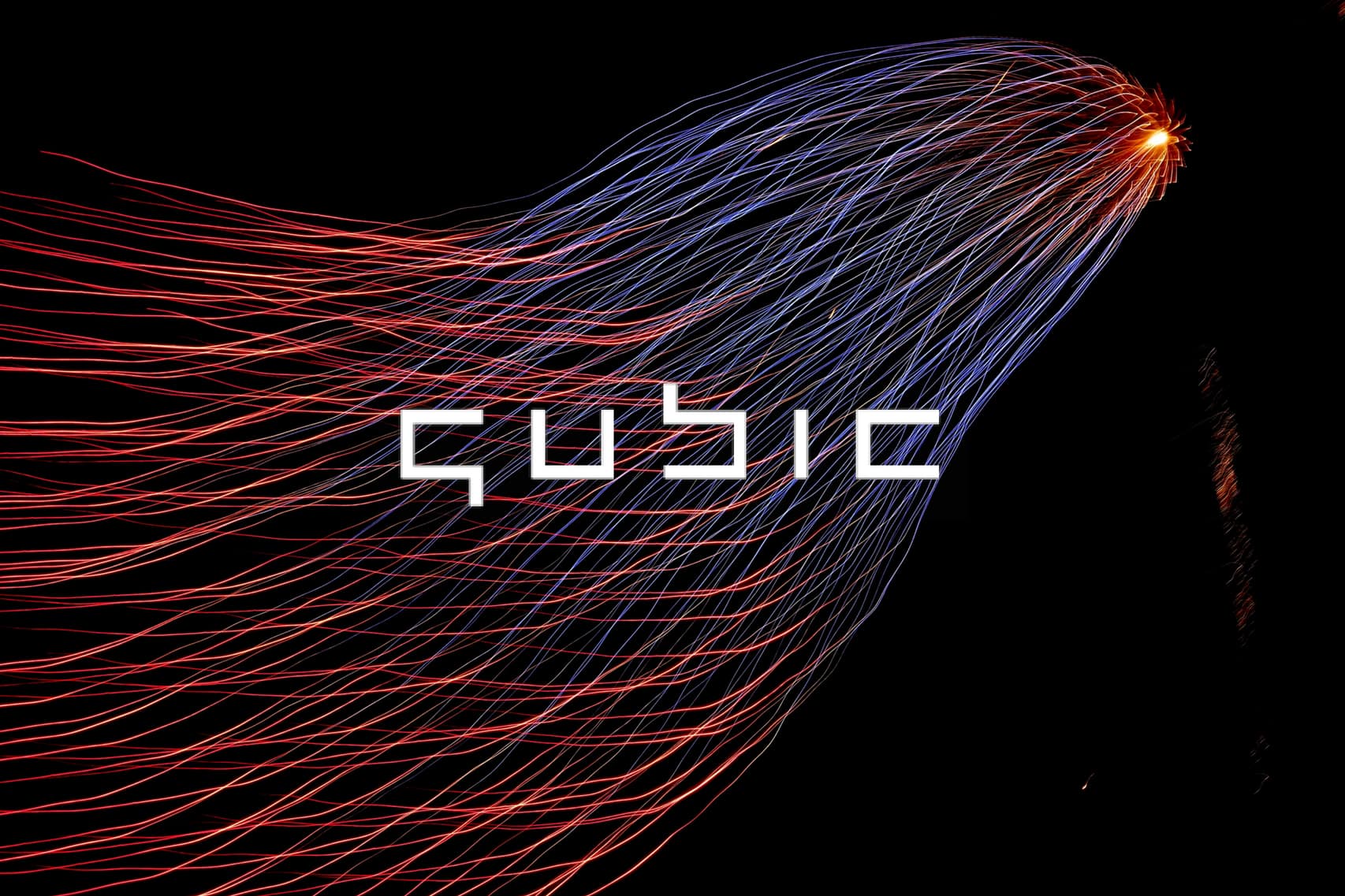On June 3, 2018, the long awaited Qubic protocol was released by the IOTA Foundation. The upgrade allows for outsourced computations, smart contracts, and oracle machines to operate in the IOTA ecosystem.
Qubic has been on IOTA’s table for years now, first making an appearance as Quorum Based Coin (QBC) on Bitcointalk threads back in 2012.
During a Reddit AMA on July 17, 2018, the Qubic development team took 2 hours out of their busy schedules to answer community questions. Detailed answers were provided by Eric Hop, Paul Douglas, and Samuel Reid.
1. Abra Development
Abra is a functional smart contract language currently being developed to build Qubic. The language has been in development for 4 years now—however, an entirely new Abra was started from scratch in early 2018.
When asked for details on short-term development targets, Eric Hop had this to say:
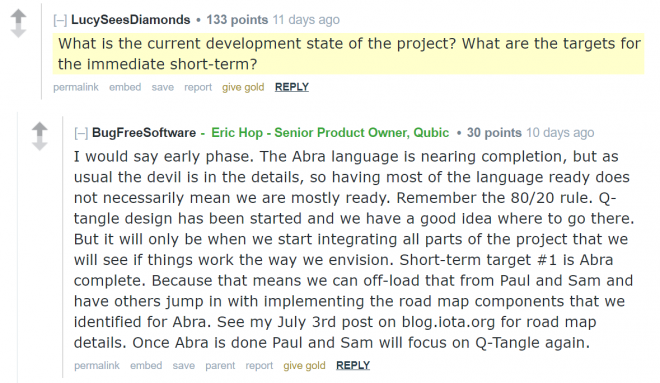
Paul Douglas, one of IOTA’s core developers, expects to have the half-completed compiler released in early Q3 2018. Releasing an initial stand-alone version of the new language will allow other developers to get familiar with it, and eventually start implementing roadmap components to the Tangle network.
When asked about Abra specifically, Hop elaborated on a few questions from the group.
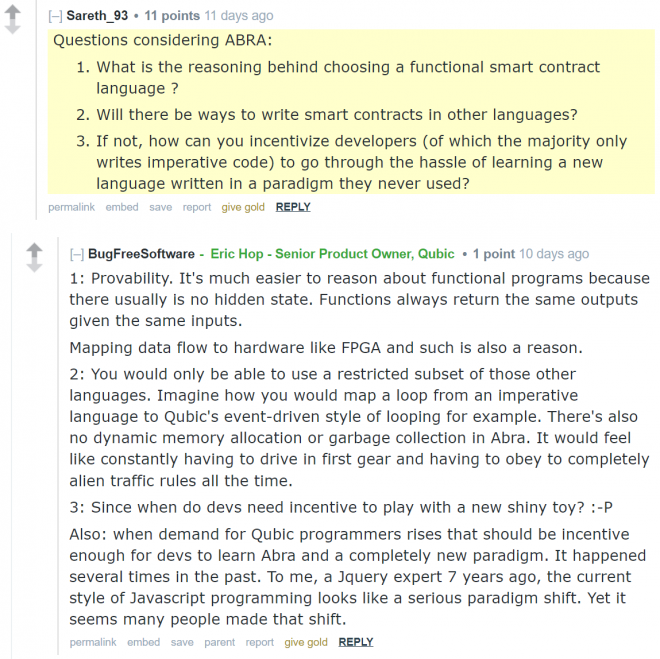
2. Qubic Challenges
The team was asked:
What is the biggest challenge with the development and implementation of the Qubic protocol right now?
Both Hop and and Reid provided lengthy answers, which were common throughout the entire AMA.
Hop responded by highlighting the difficulties of forging a new path in computer technology, specifically mentioning that unsuspected problems usually only reveal themselves after implementation has begun. He also pointed out the size of the project, and that expectations will need to be managed moving forward.
In short: be patient with us. We’re just as anxious as you guys to make this a game changer. But like I said before, we will need to bootstrap the system, which means starting with simple things, and slowly expanding to more complex things.
Roughly 7 minutes later, Reid expressed the core team’s appreciation in having the opportunity to work with IOTA. He then described their biggest immediate challenge as two-fold. Firstly, Reid sees a need to gauge exactly how much of the project’s development should be retained before releasing it to the community.
Extending off the first point, Reid wrote that the team needs to decide “how far we want to continue delving deeper into technical documentation and mathematical theory associated with the entire Qubic project and the relation to applications and use cases.”
He also echoed Hop’s observation that expectations need to be managed, and that external pressures like timelines need to be handled in a way that ensures the team is not distracted.
3. Potential Trinary Demo
The entire founding team of IOTA has been involved with blockchain technology since 2011 and 2012. However, the ternary processor project that ultimately conceived the IOTA Foundation didn’t begin until 2014.
Ternary refers to a computational system that operates on a base of 3, rather than the commonly used binary systems running on a base of 2. In short, running a ternary system is ideal for developing the Internet of Things because it’s identical to the way our brains compute. As IOTA co-founder David Sønstebø puts it:
Ternary is the optimal radix, actually Base E (2.71….) is, but you can’t make processors like that. So it comes down to Base Binary (2) vs Base Ternary (3). 3 is closer to the universal optimum 2.71 than is 2. That is the absolute most simple elevator pitch for ternary.
Prior to the Qubic announcement, a team member suggested on the IOTA Discord channel that trinary is 50% more efficient than binary, and that the team might include a demo during the June 3rd announcement.
The announcement came and went without a Trinary demo, and the topic came up during the Reddit AMA. Samuel Reid, Qubic Architect, confirmed the demo could not be shown yet, implying a public demonstration is likely to occur eventually.
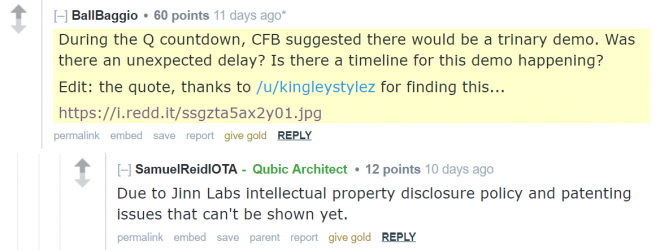
4. Bitcoin Mining vs. Qubic Processing
An important distinction was made by Hop after being asked about Bitcoin miners using their hardware for Qubic instead.
Hop explained that presently, Bitcoin mining uses application-specific integrated circuits (ASICs) to operate. This solution sacrifices general purpose processing for increased specialization, and that “FPGA or GPU based miners could probably switch to Qubic processing easily.”
He was later asked if Qubic processing would be more profitable than mining Bitcoin.

5. Qubic Alpha in 2018 Possible
In a recent Wired interview, Sønstebø mentioned the the IOTA Foundation hopes to release Qubic’s alpha application by the end of 2018. When asked if it’s an achievable goal, Douglas had this to say:
I think it’s definitely achievable. To put it bluntly, several team members have had personal things pop up, and we have been spread across multiple projects in the IOTA project as we’ve been trying to get Qubic going. Project organizational structure changed twice in the spring as the rest of IF was experiencing growing pains, which meant that old discussions had to be re-hashed, and new people had to be brought up to speed. The goalpost also moved, such that discussion of what was going on was brought to the greater community, which cost development resources as those organizing the informational resources had to draw on those who were trying to implement.
Conclusion
The Qubic team was asked some difficult technical questions, and a quick scroll through the Reddit AMA reveals the team’s commitment to answer almost every question asked.
After their 2 hours were up, the team included a message at the top of the thread, briefly mentioning their intention to do another AMA sometime in the future.
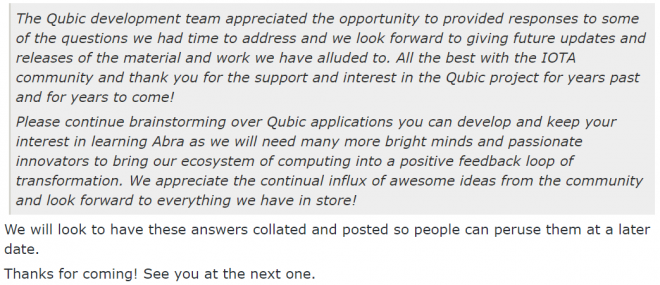
To stay connected with IOTA’s progress on Qubic, check out their website, Twitter, and Discord channel.

